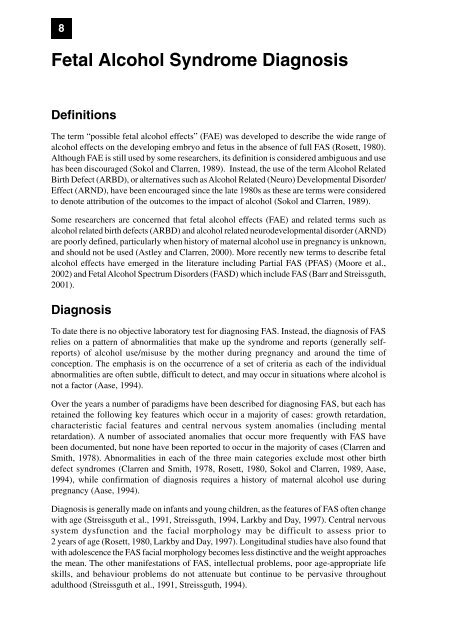Fetal Alcohol Syndrome A literature review - Department of Health ...
Fetal Alcohol Syndrome A literature review - Department of Health ...
Fetal Alcohol Syndrome A literature review - Department of Health ...
Create successful ePaper yourself
Turn your PDF publications into a flip-book with our unique Google optimized e-Paper software.
8<br />
<strong>Fetal</strong> <strong>Alcohol</strong> <strong>Syndrome</strong> Diagnosis<br />
Definitions<br />
The term “possible fetal alcohol effects” (FAE) was developed to describe the wide range <strong>of</strong><br />
alcohol effects on the developing embryo and fetus in the absence <strong>of</strong> full FAS (Rosett, 1980).<br />
Although FAE is still used by some researchers, its definition is considered ambiguous and use<br />
has been discouraged (Sokol and Clarren, 1989). Instead, the use <strong>of</strong> the term <strong>Alcohol</strong> Related<br />
Birth Defect (ARBD), or alternatives such as <strong>Alcohol</strong> Related (Neuro) Developmental Disorder/<br />
Effect (ARND), have been encouraged since the late 1980s as these are terms were considered<br />
to denote attribution <strong>of</strong> the outcomes to the impact <strong>of</strong> alcohol (Sokol and Clarren, 1989).<br />
Some researchers are concerned that fetal alcohol effects (FAE) and related terms such as<br />
alcohol related birth defects (ARBD) and alcohol related neurodevelopmental disorder (ARND)<br />
are poorly defined, particularly when history <strong>of</strong> maternal alcohol use in pregnancy is unknown,<br />
and should not be used (Astley and Clarren, 2000). More recently new terms to describe fetal<br />
alcohol effects have emerged in the <strong>literature</strong> including Partial FAS (PFAS) (Moore et al.,<br />
2002) and <strong>Fetal</strong> <strong>Alcohol</strong> Spectrum Disorders (FASD) which include FAS (Barr and Streissguth,<br />
2001).<br />
Diagnosis<br />
To date there is no objective laboratory test for diagnosing FAS. Instead, the diagnosis <strong>of</strong> FAS<br />
relies on a pattern <strong>of</strong> abnormalities that make up the syndrome and reports (generally selfreports)<br />
<strong>of</strong> alcohol use/misuse by the mother during pregnancy and around the time <strong>of</strong><br />
conception. The emphasis is on the occurrence <strong>of</strong> a set <strong>of</strong> criteria as each <strong>of</strong> the individual<br />
abnormalities are <strong>of</strong>ten subtle, difficult to detect, and may occur in situations where alcohol is<br />
not a factor (Aase, 1994).<br />
Over the years a number <strong>of</strong> paradigms have been described for diagnosing FAS, but each has<br />
retained the following key features which occur in a majority <strong>of</strong> cases: growth retardation,<br />
characteristic facial features and central nervous system anomalies (including mental<br />
retardation). A number <strong>of</strong> associated anomalies that occur more frequently with FAS have<br />
been documented, but none have been reported to occur in the majority <strong>of</strong> cases (Clarren and<br />
Smith, 1978). Abnormalities in each <strong>of</strong> the three main categories exclude most other birth<br />
defect syndromes (Clarren and Smith, 1978, Rosett, 1980, Sokol and Clarren, 1989, Aase,<br />
1994), while confirmation <strong>of</strong> diagnosis requires a history <strong>of</strong> maternal alcohol use during<br />
pregnancy (Aase, 1994).<br />
Diagnosis is generally made on infants and young children, as the features <strong>of</strong> FAS <strong>of</strong>ten change<br />
with age (Streissguth et al., 1991, Streissguth, 1994, Larkby and Day, 1997). Central nervous<br />
system dysfunction and the facial morphology may be difficult to assess prior to<br />
2 years <strong>of</strong> age (Rosett, 1980, Larkby and Day, 1997). Longitudinal studies have also found that<br />
with adolescence the FAS facial morphology becomes less distinctive and the weight approaches<br />
the mean. The other manifestations <strong>of</strong> FAS, intellectual problems, poor age-appropriate life<br />
skills, and behaviour problems do not attenuate but continue to be pervasive throughout<br />
adulthood (Streissguth et al., 1991, Streissguth, 1994).

















